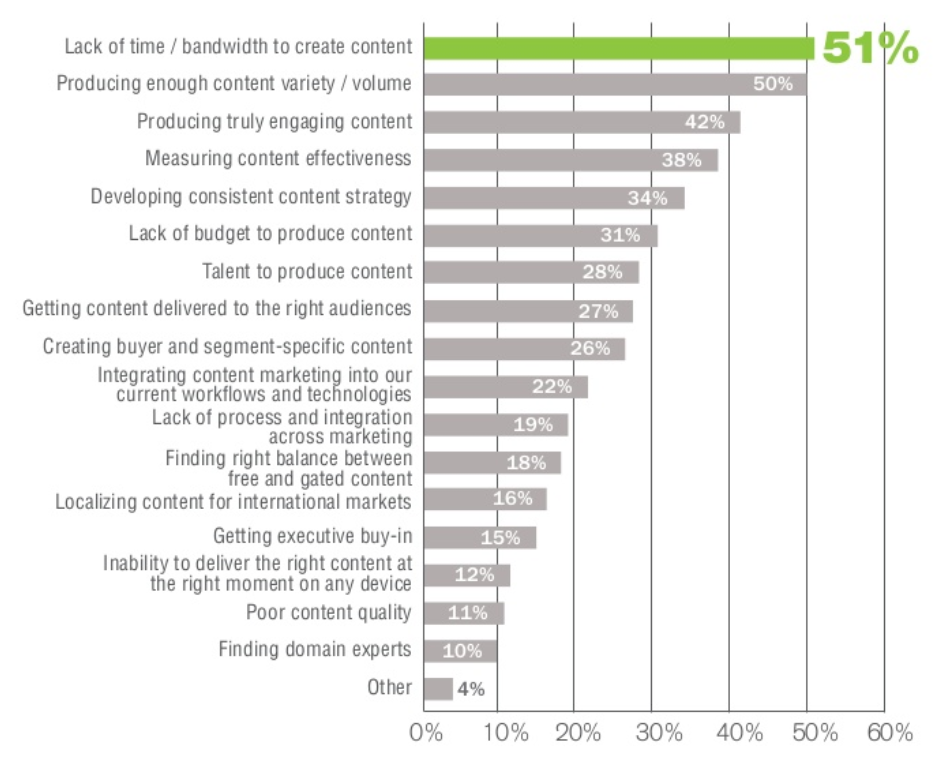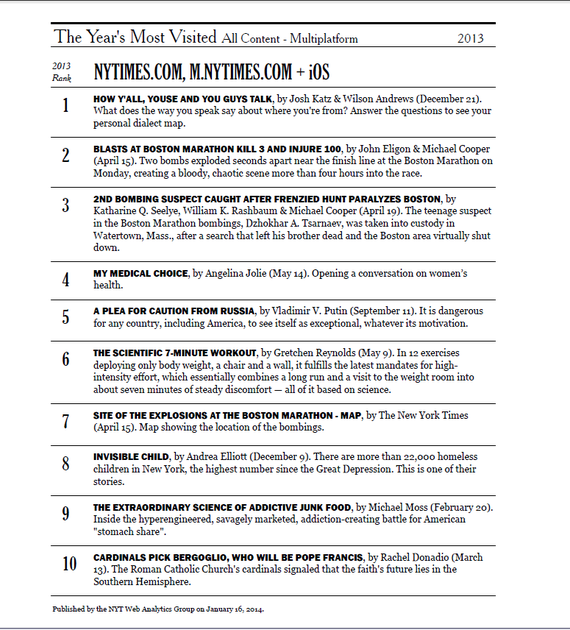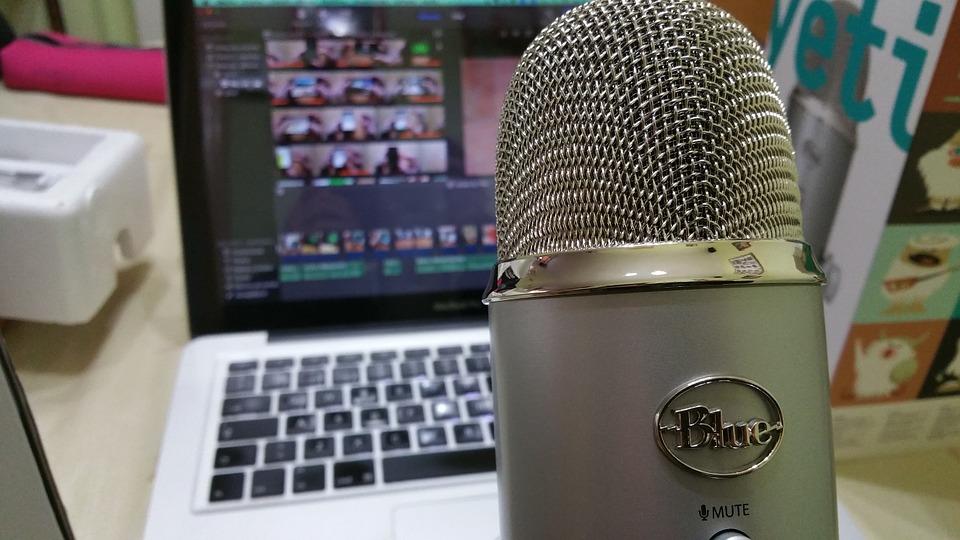How are your content marketing campaigns going?
If you’re like most businesses, you’re finding it difficult to create quality content at the level needed to maintain the momentum of your marketing initiatives.
Don’t worry though – you’re absolutely not alone. According to one study, the two biggest problems facing content marketers are:
- A lack of time or bandwidth for creating content (51%)
- Producing a wide enough variety and volume of content (50%)
As content marketing continues to grow in popularity, brands are investing more money in content development:
- 70% of marketers are making more content than they were a year ago.
- The most effective marketers are spending 39% of their budget on content marketing.
This means it’s more crucial than ever to ensure that you’re producing as much quality content as possible. Failing to do so may mean losing out to more proactive competitors.
Reusing Content
So what’s the solution? It’s certainly not a good idea to reduce quality:
- 69% of brands struggle to maintain a high quality level.
- Cranking out content without worrying about quality can seriously damage your brand’s reputation.
If you’re wanting to maximize your content production without reducing quality, you’ll need to work smarter, not harder.
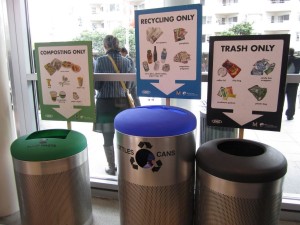 By recycling, reworking and reusing content, you can turn a single blog post into over fifty different pieces of content.
By recycling, reworking and reusing content, you can turn a single blog post into over fifty different pieces of content.
- Some will be large, while others will involve a lot of smaller snippets.
- This way, the same content can be reused across a variety of mediums.
- Through careful planning, you can make the most of every single content idea.
So, let’s have a look at some of the most practical ways to expand a single piece of content into a variety of different marketing pieces:
Straight Conversions
In order to get the most out of your content, you’ll likely need to do some editing. This helps to produce:
- Multiple ‘new’ pieces of content’.
- Different content for a variety of platforms.
That said, there are plenty of ways to reuse your original text without much editing at all.
Content Pieces #1-2: Free Ebook and White Paper
By giving away a free ebook or white paper, you’re catering to an audience that might not have bothered to read your blog.
After all, according to Neil Patel, ‘…white papers are really nothing more than repurposed blog posts especially if you have some really good how-to blog content’.
It helps that research has shown that these forms of content appeal particularly to prospective clients:
- 83% of B2B clients say have used white papers to make purchasing decisions within the last year.
- 68% have used free ebooks.
- This compares with just 56% who used blog posts.
There are plenty of online templates available to quickly and easily turn your blog post into a white paper or ebook, making this a simple way to get more out of your content.
Content Pieces #3-7: Five-Day Article Series
 Long-form content offers substantial digital marketing benefits, but that doesn’t mean that all of your readers have time to sit down and consume thousands of words every day.
Long-form content offers substantial digital marketing benefits, but that doesn’t mean that all of your readers have time to sit down and consume thousands of words every day.
Instead, reach a different demographic of readers by breaking things down.
This first step in transforming your single blog post into multiple pieces of content may take a while, but it’s important to help you get the most out of your content.
Start by breaking down your article into bite-size chunks.
Instead of posting one long article at first, take it apart and develop five articles from the points contained within.
- With a little embellishing, you can turn a single article into five different articles.
- Each article can offer a slightly more in-depth look at each point.
Smaller articles might not be quite as good for SEO, but they still serve a purpose:
- Rapid fire shorter content means more articles on your site to link to.
- An article series gives site visitors something to keep coming back for every day.
- Each can serve as the basis for more content.
Break It Down
What else can you do with five short articles?
Content Piece #8: Email Newsletter
Considering the importance of a strong email newsletter, you’ll want to have some some solid content to share with subscribers.
Your five articles make up a great collection of content snippets to add value to a week’s worth of emails – all you have to do is upload the shorter posts you’ve already created to your email service.
Content Piece #9: New Subscriber Drip Email Perk
Alternatively, your five well-written short articles are the perfect fodder for a drip email campaign for new subscribers that will:
- Promise subscribers the perk of a short email each day for five days.
- Increase the subscriber’s brand engagement, as you’ll be on their minds every day when they first sign up.
- Demonstrate what kind of quality content users will get from your site.
- Drive a 12x increase in click-through-rates (for sites that use drip email campaigns for new subscribers).
Okay, so you’ve got your five articles. But what if you break them down to even smaller chunks?
Content Piece #10: Fact List
The internet loves a good list – a collection of short, sweet factoids that are easy to digest and are a godsend for anyone who’s researching the topic you’re writing about.
- This of course means that anyone writing an article on the same subject as yours will link to you, which is good for a huge number of reasons.
- Primarily, it’ll help build your authority – giving site visitors no mess facts helps the accessibility of your content.
Content Piece #11: Fact Tweets
 ‘Did You Know’ facts do very well on social media – you can use a variety of the facts from your list to produce short posts.
‘Did You Know’ facts do very well on social media – you can use a variety of the facts from your list to produce short posts.
- Considering that the best average tweet length is around 100 characters, these small snippets make perfect social content.
- Snippets from your fact list can also be used on other social media such as Facebook – I’m just splitting the difference here.
Content Piece #12: Key Quotes List
Quotes stand out, especially if they use bold visuals and funky fonts.
Sometimes, it’s better to give readers a big list of easily shared quotes rather than a full text article.
- This keeps people reading.
- It helps users to spot the most important points.
- A quote list can easily be reworked into a variety of social media posts and other content.
A list of quotes also helps because, as with facts, when other people who are writing articles on your subject matter come along, it’ll be quick and easy for them to grab a quote from your list to lend authority to their research.
This helps further increase your authority, and generates more traffic for your site.
Content Piece #13: Quotation Facebook Post
As with factoids, simple quotes can make excellent little pieces of social media content.
- You can fire out several over the course of a day, or post one a day for an extended period.
- Every additional post will link back to your original article or your quotes list, to help drive further traffic to your content.
Distributing your killer quotes through Facebook can add variety to your social media content and can help to build your perceived authority on the topic at hand.
Content Piece #14: Quizzes
‘How well do you know X? Text yourself with this online quiz!’
Did you know that the number one most read piece of content on the New York Times website in 2013 was an interactive quiz?
A quiz is a fantastic way to draw users to your site, while also making use of your existing content. People love a chance to test themselves.
Even better, once you’ve created a broken down list of factoids, turning each key element of your article into a quiz question is extremely simple, and doing so helps further develop your authority – especially as you can link to your own five articles as information sources in the answers.
Being Helpful
Good content is more than just thinly veiled advertising.
You want your content to help people with a problem. Doing so:
- Makes your content more valuable to users.
- Builds trust in your brand.
- Convinces potential customers that your products will meet their needs.
There are a variety of ways that you can adapt your content to meet the needs of online
Content Pieces #15-16: How To Guide and Checklist
How-to guides are a fantastic way to rework old content with authority, as they appeal to users who are looking for specific instructions on how to complete a particular task.
- If they’re after learning more about how to do the things you’re blogging about, chances are they’re also excellent customers in the making.
Checklists are similar to guides, but they’re the bare-bones version – kind of like the facts lists and quizzes above, they give specific instructions to anyone who wants to get things right.
In practice, they’re more likely to appeal to audience members who are worried about missing a crucial step in a given process and want to interact with the guide on an ongoing basis (and who are, again, perfect potential customers).
Content Piece #17: Quora Post
Chopping apart the advice given in your blog post even further, you can use it to answer questions on Quora.
- Doing so will help build your brand’s authority on the subjects you’re talking about.
- It’ll also help subtly draw people to your website.
Just don’t make sure your answers aren’t simply blatant advertisements for your products – nobody will respect that, even if your answers are good.
Content Piece #18: FAQ
By this point, after working through your various forms of content, there’s a good chance that people will be asking questions about your blog post.
- Some points may need further clarification.
- Sometimes readers will have questions about how to implement ideas.
To help address these points, you can write a follow-up article addressing the common questions and concerns that have arisen from your original article.
Not only will readers appreciate you clarifying any points of confusion, but this gives you an opportunity to help site visitors who are a little further down the conversion funnel and are thinking about the practicalities of your product.
Images
 Just because your original content is all text doesn’t mean that there aren’t plenty of ways to create image content as well.
Just because your original content is all text doesn’t mean that there aren’t plenty of ways to create image content as well.
- They slow down users enough to grab their attention.
- They help users to grab a message as quickly as possible.
Here are a few ways to quickly put images to work for your content:
Content Piece #19: Viral Images
Remember our lists of facts and quotes from earlier?
It doesn’t take much effort to place them on a colorful background and turn them into perfect visual content:
- Recite turns quotes into images with a few clicks
- Over puts text on top of photo backgrounds
- Quotes Cover allows you to turn quotes into perfectly sized social media profile pictures and page covers.
These pieces of visual content go great on blogs, as well as being useful to use as promotional materials and to make your social media profiles informative as well as visually impressive.
Content Pieces #20-24: Image Tweets, Facebook Pictures, Instagram Posts, Pinterest Boards and Tumblr Posts
 Among the best ways that you can use the new images you’ve created is on social media.
Among the best ways that you can use the new images you’ve created is on social media.
- Twitter loves images, and tweets with pictures perform significantly better than posts without.
- Instagram is the second largest social media platform, and is entirely image-based.
- Pinterest is used by a variety of businesses, and using your images to create your own personalized image boards can help develop your following.
- Tumblr has a relatively small user group, but it’s perfect if your target demographic is young and tech-savvy.
Each social media platform has its own unique quirks, so you’ll want to tailor your images to each one. But making content for each of these social media spheres can help get your message out to as many people as possible – as quickly as possible.
Content Piece #25: Infographic
A good infographic is one of the best pieces of content you can produce.
- 39% of B2B buyers regularly share infographics on social media.
- 52% of B2B marketers used infographics in 2014.
Infographics draw in readers thanks to their engaging visuals and rich, useful content. Adapting your blog post into an infographic can make a huge difference in your website’s performance.
Content Pieces #26-30: Infographic Collection
Why stop with just one infographic? If you’ve expanded your article into a series, it’s easy to adapt all five of the new articles you’ve created into infographics that cover each of your main points in depth.
Content Piece #31: Slideshow
Cutting up your infographics lets you turn them into a slideshow.
And in my experience, sharing content on Slideshare makes sense:
- The site receives over 60 million visits per month
- One marketer received a 50x return on investment just from slideshows.
Slideshows provide quick and easy facts in a compelling visual presentation, and are excellent for drawing interest from potential customers who are grateful for free access to the slides.
Content Piece #32: Instructographic
Much like an infographic, an instructographic communicates a message visually.
The difference is, it teaches the reader how to do something – rather than just giving them information.
- Instructographics can be easily made by combining visuals from your infographic with your how-to guide.
- Instructographics share particularly well on Pinterest.
As with the various forms of text content described here, an instructographic helps you to reach out to different groups of clients than the ones who would be drawn in by your infographic.
Content Piece #33: Video
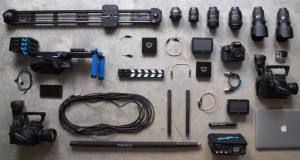 One of the most popular forms of content on the internet is video.
One of the most popular forms of content on the internet is video.
- 100 million internet users watch online videos every single day.
- Online video makes up 50% of all mobile internet traffic.
- Video ads lead to a 97% increase in purchase intent.
Your blog article already lays the framework for a video:
- It provides the transcript.
- It can be easily combined with visuals from your infographic.
- You can use it to quickly and simply create a video with strong production value that does a fantastic job of selling your product for you. All you need is a smartphone and some basic lighting.
Content Pieces #34-39: Web Series
Why stop with just one video?
(Are you seeing a theme here yet?)
As with your infographic, the series of text articles you’ve created are also perfect for adaptation into a video series.
A video series offers several benefits:
- It keeps site visitors returning to your site for more content.
- You can lead viewers organically from one video to the next, keeping them watching for longer.
- A series of videos can address concerns that viewers have at different points on the conversion funnel.
Content Piece #40: Vines
Vines are tiny videos that are only a few seconds long.
- They work best when they’re short and to-the-point.
- As such, they’re the perfect way to adapt your factoids for video.
- You can make loads of quick vines out of your video content.
- Each one serves as an advertisement for your full video series on the subject.
Content Pieces #41-45: Podcasts
Podcasts are useful for users who want to enjoy your content while performing other tasks, such as driving, exercising, or tackling dull paperwork.
You can use the audio from your videos, based on the text of your original article, to make a series of quick and easy podcasts that can be listened to by brand followers anytime, anywhere.
Creating podcasts helps further the reach of your content, no matter what their preferred media choice is.
Content Piece #46: Webinar
This one might take a little more work to adapt your content, but it’s possible to use your text to produce the basis of a webinar which teaches viewers the lessons covered by your article.
Interestingly, webinars have been ranked among the most effective content marketing techniques by today’s marketers:
- In one survey, 92% of marketers said that they considered webinars effective.
All you need for a webinar is a series of slides (which you already have) and someone to stand in front of a camera to teach the points in your article.
From this, you can drive a tremendous amount of interest in your brand and your content marketing efforts.
Content Piece #47: FAQ Webinar Follow-Up
In a similar way to how writing a follow-up FAQ for your article can help address issues and concerns for readers while helping to produce more quality content, you can use the same webinar setup to deliver responses to the questions viewers have about the topics you’ve discussed.
When you respond directly to a viewer, you help to build a relationship of trust with them that encourages them to refer to you for information, advice, and product help.
This can lead to greater sales, and as it’s a subject you’ve already thoroughly researched, it doesn’t take much effort for you to answer questions your viewers might have.
Re-Releasing Content
Remember the Special Edition Star Wars movies?
 Back in 1997, George Lucas re-released the original movies with some added special effects and deleted scenes.
Back in 1997, George Lucas re-released the original movies with some added special effects and deleted scenes.
This helped get fans back into the movie theaters and generated hype for the upcoming prequel films.
By making a few simple changes, you can rework older articles to make them relevant for a whole new generation of potential clients.
Content Piece #48: Updated Article
Perhaps it’s been six months or a year since you originally posted your article online.
Now’s the time to revisit it, adding an additional few paragraphs about the developments in your field since it was originally written.
- This helps bring your old, well-written content back into relevance.
- It also helps prevent your content from appearing out of date when anyone comes across it in a search.
You can similarly update many of the above content pieces – web videos, infographics, ebooks and white papers – to reflect these changes, creating even more content at your disposal.
Content Piece #49: Guest Post
Okay, so one thing you can’t do is submit an article that you’ve already written as a guest post for another site.
 But by rewriting the article from a slightly different perspective or with a slightly different focus, you can rework the original text to produce fresh content that will make a big splash as a guest post.
But by rewriting the article from a slightly different perspective or with a slightly different focus, you can rework the original text to produce fresh content that will make a big splash as a guest post.
What’s more, you can link back to your original post within the guest post to support those who want to know more on the same topic.
This is a great way to make the most of your existing article’s potential.
Putting It All Together
Content Piece #50: Resource Pack
By this point, among other things, you’ve turned your single blog post into:
- A white paper
- An ebook
- Several infographic
- Various images
- Videos
- Podcasts
Now, it’s time to bundle everything together and offer it as a downloadable or members-only access resource pack for anyone looking to learn more about the subject.
These resource packs are useful for anyone who wants to learn more about the subject, as well as anyone who’s performing research for producing content of their own.
This means that:
- You develop your reputation as an authoritative and helpful source for prospective clients.
- You can convert other content marketers into proxy salesmen as they go about using (and referencing) your resources.
Well done – you’ve turned a single blog post into fifty pieces of useful content that’ll help you take your content marketing efforts to new levels.
Using the ideas I’ve discussed will help you to get the most out of every single piece of content and help you to increase the amount of content that you produce. But this list certainly isn’t comprehensive.
If you have another strategy you’ve used successfully to transform one piece of content into another, I’d love to hear about it. Share your best tips and tricks by leaving a comment below:
Images:
Flickr, Slideshare, Flickr, Pixabay, Pixabay, New York Times, Quora, Pixabay, Pixabay, Slideshare, Pixabay, Pixabay, Pixabay, Flickr, Wikipedia.




